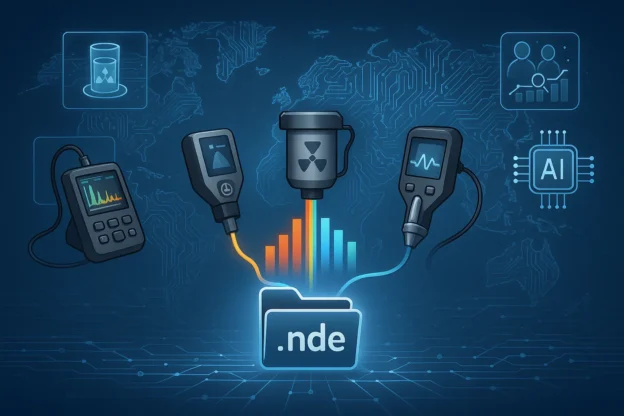As we move into a fully digital era, the Nondestructive Testing (NDT) industry faces a crucial challenge: the need for a common file format. Just as medical professionals around the world share image data through standardized file formats, adopting a universal file format in NDT could unleash unprecedented levels of collaboration, efficiency and data management.
Imagine a world where NDT professionals, regardless of their equipment brand or inspection technology, could easily share and access data. Today, it is common practice for equipment manufacturers to use different proprietary file formats, which isolates brands – and even product lines – preventing data sharing between them. This lack of standardization fragments the industry and limits the ability of teams to work together seamlessly. But there is a promising answer: the .nde format. Designed to unify inspection data, .nde could be the key to creating a more cohesive and accessible NDT landscape.
Why .nde?
The .nde format was developed to counteract the limitations of proprietary file formats. It offers NDT professionals an open and accessible format that does not tie them to specific software, making data usable in all domains. Based on the versatile HDF5 framework, .nde supports a wide range of platforms, allowing data to be clearly and universally accessible and organized.
This means: no more proprietary software barriers, no file size limits and the freedom to choose software based on functionality, not file compatibility.
Opening doors for the industry
Adopting a universal format such as .nde would unlock possibilities for NDT. Imagine experts from different companies collaborating on the same data set, comparing findings or seamlessly accessing historical records. With a universal format, third-party applications could also gain access, making it easier to integrate NDT data into inspection data management systems (IDMS), digital twins and artificial intelligence (AI), without the current compatibility hurdles.
Improved interoperability could even empower auditors and regulatory bodies to maintain impartial and transparent industry data reviews across different modalities.
Beyond DICONDE: Meeting diverse data needs
While DICONDE (Digital Imaging and Communication in Non-Destructive Evaluation) has been the pioneering open file format for many years and has sufficiently supported radiographic test data, it does not meet the needs of more complex NDT methods, such as ultrasonic or eddy current testing.
These methods often generate large, detailed data sets that require full access to the raw information to provide accurate analysis. The .nde format overcomes these challenges by accommodating complex data structures while maintaining compatibility with the simpler DICONDE data when necessary. This dual capability allows for both backward compatibility and forward-looking data richness.

Future-Proofing Through Flexibility
Based on HDF5, .nde is a stable choice that ensures long-term usability of NDT data. The hierarchical structure and adaptability of HDF5 allow files to be accessed and organized efficiently across multiple platforms and programming languages.
In addition, the open source nature of HDF5 minimizes the risk of obsolescence and can be extended to include cybersecurity measures, providing a robust framework for protecting data.
The Path Forward: Uniting for a Stronger NDT Community
As NDT technology advances, the need for a universal language becomes imperative. A shared file format would free inspectors, manufacturers and asset owners from the constraints of software, allowing them to use the data they collect in any way they choose.
By standardizing the use of the .nde format, the industry could eliminate many compatibility barriers, accelerating collaboration and innovation in the field. As damage mechanisms continue to evolve, so must our knowledge and methods.
An increase in the fluidity of information exchange could create valuable learning opportunities, advancing both the NDT industry and society as a whole.
In short, adopting the .nde file format means empowering the NDT community with a consistent, accessible and flexible foundation that supports current needs and adapts to future demands. A common data language is not just a technical advancement, it is an invitation for the entire NDT industry to work as one, fostering progress and learning for the benefit of all.
This article was developed by specialist Emilie Peloquin and published as part of the fourth edition of Inspenet Brief magazine December 2024, dedicated to technical content in the energy and industrial sector.

